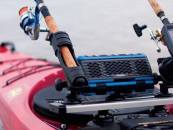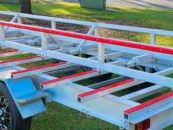When buying or renovating a traditional house, the focus is very much on the structure and design. However, with waterfront properties, a great premium is set for the infrastructure on the shoreline that accommodates boats, jet skis and non-motorised watersports. So getting the on-water design right is just as important as the style and design of the house.
Installing the right type and size of pontoon will add value to your property, so here is some sensible advice to help you choose the best set-up for your dream home.
PILED OR CABLED PONTOON – Piled pontoons are floating structures fixed in place with large steel or concrete posts that are sunk into the seabed. Piles are usually used in waterways that have strong tidal flow where the pontoon must be held in place firmly. The pile pontoon system is engineered to stand up to the riggers of more exposed areas and for mooring larger vessels. In calmer waters, the pontoon can be attached to land using aluminium struts or cables. The strut pontoon system is an intermediate design that provides more mooring capacity and the ability for a larger floating pontoon without the need for piles. The cable pontoon system, is perfect for more sheltered areas and home owners looking for a cost effective pontoon solution. The floating pontoon is a more modest size, connected back to engineered points on land via the access gangway and stainless steel cables.
DRY BERTHING – The ideal mooring solution for your boat is out of the water, it eliminates the need for routine antifouling and will help guarantee the longevity of your vessel. Rolling your boat up onto the deck of your pontoon with a purpose built roller system allows you clear access to undertake maintenance and it provides you with security in knowing your boat is out of the water. If you boat is under 6.5m long and weights less than 1500kg, then you can install a dry berth pontoon that incorporates a tapered end, allowing for a boat or jet ski to be parked on top of the pontoon using a roller system with electric or manual winch.
WIDTH OF PONTOON – When considering a dry berthing pontoon that places your vessel on top, the recommended pontoon width is 3.5m. A 6m boat will have an average beam over 2.3m, therefore allowing enough space to be able to walk safely down each side of your boat. This is handy prior to launching and during loading, and allows for some elbow room for maintenance and cleaning.
LENGTH OF PONTOON – The ideal size pontoon is 8m or 10m which allows extra space to move around and a few metres for boat growth in the future. Council regulations allow your pontoon to be up to 70% of your total waterfront property length. The pontoon is a good investment in your property, not only does it increase the value of your home, it also makes the home more desirable to boaters when selling. Every square metre of pontoon space becomes useable space on your property to be enjoyed by you, your family and friends.
WET BERTHING – More common on the Gold Coast are wet berth pontoons, where the boat is moored in the water alongside the pontoon. For wet berths the ideal width is between 2.4m and 3.5m. The wider pontoon the better, as narrow pontoons tend to be a little unstable and leave very little room for storage of non-motorised watersports and all the extras that commonly end up stored on your pontoon.
FREEBOARD HEIGHT – One of the more technical decisions to make is the height of the freeboard – the actual height the pontoon sits out of the water. If you are considering dry berthing your boat, then order a pontoon with extra freeboard so that when the boat is on the pontoon the aluminium frame work will also be out of the water. The extra freeboard height is very important if you are positioned on a main river with ski zones (like the Nerang and Coomera rivers). Power boats, especial wakeboarding boats, make large waves. A pontoon that has a high freeboard will be more durable to crashing waves and will stay drier.
You can check with your local council to confirm the current pontoon and jetty specifications as many council now allow these structures to be moved further out to avoid touching the sand at low tide and ensuring deeper water for boat access. A reputable pontoon company would do this as part of their service at no extra cost. In selecting your pontoon company, look for quality, a fully engineered and compliant solution that has been tested over time for durability and low maintenance in large commercial marinas.
www.pacificpontoon.com



























